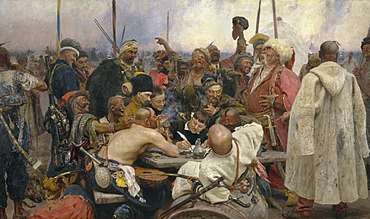Orenburg Cossacks
The Orenburg Cossack Host (Russian: Оренбургское казачье войско) was a part of the Cossack population in pre-revolutionary Russia, located in the Orenburg province (today's Orenburg Oblast, part of the Chelyabinsk Oblast and Bashkortostan).

| Part of a series on |
| Cossacks |
|---|
 |
| Cossack hosts |
| Other groups |
| History |
| Cossacks |
| Cossack terms |
After having constructed fortifications around the future town of Orenburg in 1734, they officially founded it in 1735. For the purpose of defending the city and colonizing the region, The Russian government relocated the Cossacks from Ufa, Iset, Samara and other places and created the Orenburg non-regular corps in 1748. In 1755, a part of it was transformed into the Orenburg Cossack Host (or Voisko) with 2,000 men.
In 1773—1774, the Orenburg Cossacks took part in Yemelyan Pugachev's insurrection. In 1798, all of the Cossack settlements in the Southern Urals were incorporated into the Orenburg Cossack Host (except for the Ural Cossacks). A decree of 1840 established the borders of the Host and its composition (10 cavalry regiments and 3 artillery battalions). In the mid-19th century, the Cossack population of this region equaled 200,000 people.
The Orenburg Host participated in the Russo-Swedish War of 1788–1790, and later in the campaigns that Russia waged in order to conquer Central Asia.
The Orenburg Host consisted of 2 districts, or okrugs (after 1878 - 3 departments, or otdels). By 1916, the Cossack population of this region had grown to 533,000 people occupying a territory of 7,45 million desyatinas. One desyatina equaled 2,7 acres (11,000 m²). In the early 19th century, the Orenburg Cossack Host supplied 6 cavalry regiments, 3 artillery battalions, 1 cavalry battalion, 1 sotnya (100 men) of guards and 2 detached sotnyas. During World War I, the Orenburg Cossack Host supplied 18 cavalry regiments, 9,5 artillery battalions, 1 cavalry battalion, 1 sotnya of guards, 9 unmounted sotnyas, 7,5 reserve sotnyas and 39 detached and special sotnyas (to a total of about 27,000 men).
After the October Revolution of 1917, the leadership of the Orenburg Cossack Host, under the command of Ataman Alexander Dutov, fought against the Soviets. The poorer Cossacks joined the ranks of the Red Army. The 1st Orenburg Cossack Socialist Regiment took part in the Ural Army Campaign of 1918.
In 1920, the Orenburg Cossack Host ceased to exist.
Distinctions
The distinguishing colour of the Orenburg Cossack Host was light blue; worn on the cap bands, shoulder straps and wide trouser stripes of a dark green uniform, of the loose-fitting cut common to the Steppe Cossacks. High fleece hats were worn on occasion with light blue cloth tops.[1] Officers wore silver epaulettes and braiding.[2] After 1907 a khaki-grey service uniform of standard Imperial Cavalry pattern was introduced but the light blue distinctions were retained until 1920.
See also
- Nagaybaks, Tatar-speaking Cossacks belonging to the Orenburg Host
References
- Kenny, Robert W. Uniforms of Imperial & Soviet Russia in Color. p. 89. ISBN 0-7643-1320-7.
- Emmanuel, Vladimir A. The Russian Imperial Cavalry in 1914. pp. 89 & 93. ISBN 978-0-9889532-1-5.
- Petr I. Avdeev Istoricheskaya Zapiska ob Orenburgskom Kazach'em Voiske, 1904
